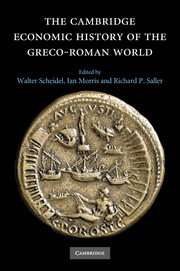Book contents
- Frontmatter
- 1 Introduction
- Part I Determinants of Economic Performance
- Part II Early Mediterranean Economies and the Near East
- Part III Classical Greece
- 12 Classical Greece: Production
- 13 Classical Greece: Distribution
- 14 Classical Greece: Consumption
- Part IV The Hellenistic States
- Part V Early Italy and the Roman Republic
- Part VI The Early Roman Empire
- Part VII Regional Development in the Roman Empire
- Part VIII Epilogue
- Bibliography
- Index
- Map 1.1 The Mediterranean basin"
- Map 10.1 Greek and Phoenician trade in the period of the Persian Wars"
- Map 11.1 The Achaemenid empire"
- Map 12.1 Greece and Asia Minor"
- Map 15.1 The Seleucid empire"
- Map 16.1 Greco-Roman Egypt"
- Map 20.1 The Roman empire at the accession of Vespasian"
- References
13 - Classical Greece: Distribution
from Part III - Classical Greece
Published online by Cambridge University Press: 28 March 2008
- Frontmatter
- 1 Introduction
- Part I Determinants of Economic Performance
- Part II Early Mediterranean Economies and the Near East
- Part III Classical Greece
- 12 Classical Greece: Production
- 13 Classical Greece: Distribution
- 14 Classical Greece: Consumption
- Part IV The Hellenistic States
- Part V Early Italy and the Roman Republic
- Part VI The Early Roman Empire
- Part VII Regional Development in the Roman Empire
- Part VIII Epilogue
- Bibliography
- Index
- Map 1.1 The Mediterranean basin"
- Map 10.1 Greek and Phoenician trade in the period of the Persian Wars"
- Map 11.1 The Achaemenid empire"
- Map 12.1 Greece and Asia Minor"
- Map 15.1 The Seleucid empire"
- Map 16.1 Greco-Roman Egypt"
- Map 20.1 The Roman empire at the accession of Vespasian"
- References
Summary
introduction
All regions bordering the Mediterranean Sea make use of the relatively easy connectivity it provides. People and goods move around fairly easily, but not without the risk of wreckage or piracy. This condition allows both for the growth of refined demand and at the same time for its corollary – specialization of production. Distribution refers to the circulation and allocation of products and services, providing for both basic needs and luxuries. We consider the motors of distribution from two complementary sides: production and demand. Production is a result of environmental factors and sociopolitical forces, depending on opportunity as much as on limitations. Demand grows from need and desire, which arises when goods are known and available. Social constraints and chance shape consumption; hence demand follows value-rational decisions. A distribution system’s success or failure in supplying needs and desires depends on institutions, the formal and informal rules a society employs. Institutions, however, result from negotiations within a society, guided by social norms and values. They are both realities and cultural creations, changing their meanings and causing conflict. Thus, a society’s ability to adapt to changing outside parameters and to adjust its institutions determine the performance of its distribution system.
objects
The image of classical Greece as an essentially self-supporting agricultural system, creating little surplus and low aggregate demand (with just a few exceptions, such as the urban agglomeration of Athens) is increasingly being questioned. The growing number of shipwrecks suggests expanding seaborne trade, although in quantifying these data we must be wary of the impact of patterns of archaeological research and post-depositional transformations of the record.
Keywords
- Type
- Chapter
- Information
- The Cambridge Economic History of the Greco-Roman World , pp. 362 - 384Publisher: Cambridge University PressPrint publication year: 2007
References
- 16
- Cited by



